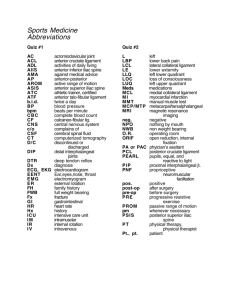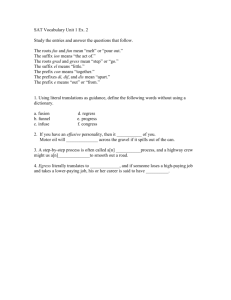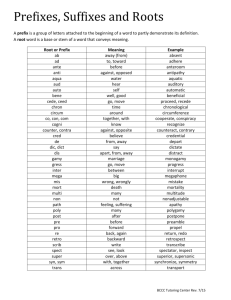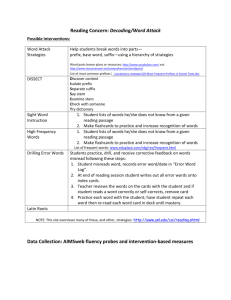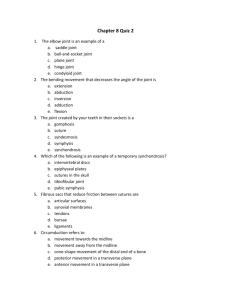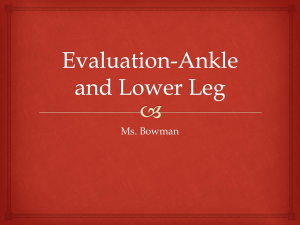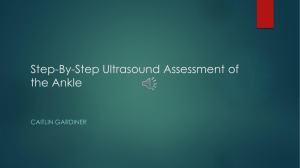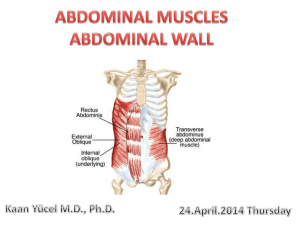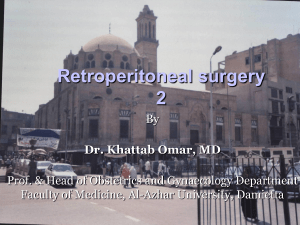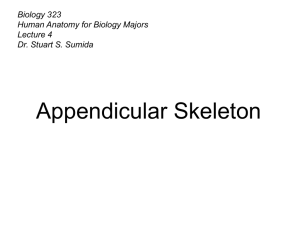Medical Terminology: Prefixes, Suffixes, Roots & Abbreviations
advertisement
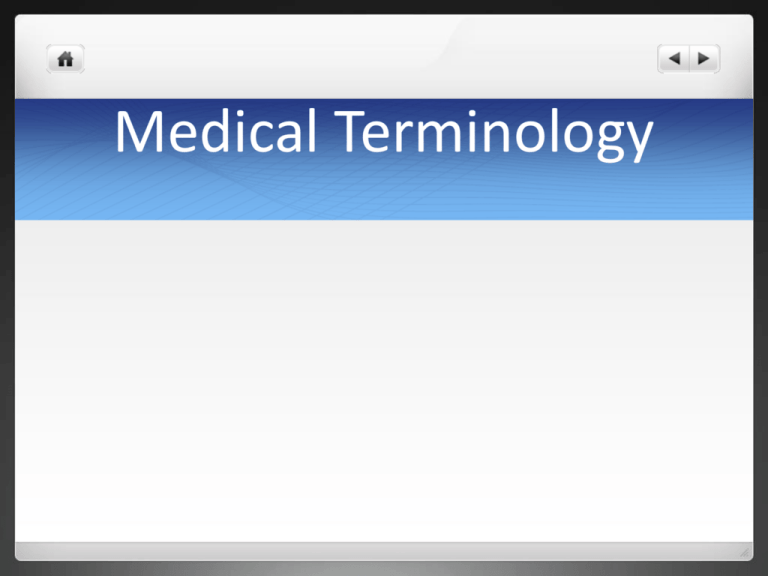
Medical Terminology http://www.dmu.edu/medterms/basics/ Basics Before we can start in with some new and interesting medical terms, you need to learn a few fundamentals of how medical terminology is constructed as a language. There are three basic parts to medical terms: a word root (usually the middle of the word and its central meaning), a prefix (comes at the beginning and usually identifies some subdivision or part of the central meaning), and a suffix (comes at the end and modifies the central meaning as to what or who is interacting with it or what is happening to it). An example may make better sense. Word root therm = heat hypothermia (less heat), thermometer (measuring heat) Let’s look at a real medical term and take it apart. Myocarditis (prefix) (root) (suffix) myo = muscle card = heart itis = inflammation Don’t get blown away by that big, intimidating word! We haven’t introduced word roots yet. I just wanted to demonstrate the major parts of a medical term. Let’s see how prefix and suffix changes can alter the meaning of a term without changing its central meaning by keeping the root the same. Prefix change: myocarditis = muscle layer of heart inflamed pericarditis = outer layer of heart inflamed Endocarditis = inner layer of heart inflamed Suffix change: cardiologist = a physician specializing in the heart cardiomyopathy = damage to heart muscle layer cardiomegaly = enlargement of the heart Again, we haven’t introduced heart terms yet. These basics are just to introduce the parts of medical terms and demonstrate how moving the parts around modifies the central meaning without changing the “root” (cardio). Useful prefixes and suffixes Following, in no particular order, are frequently used word beginnings (prefixes) and word endings (suffixes) used to make up many medical terms. You don’t need to memorize whether an item is a prefix or suffix, or even if it is a word root, just what it means! I know this is all “Greek” to you (and some of it really is!), but there will be so much reinforcement as we go along that you can’t help but remember meanings. Be patient with yourself. -itis -osis = inflammation = abnormal condition -ectomy -otomy = to cut out (remove) = to cut into -ostomy = to make a “mouth” a/an = without, none micro = small macro = large Mega/megaly = enlarged -scopy/scopic = to look, observe tonsillitis, appendicitis cyanosis (of blueness, due to cold or low oxygen) appendectomy, tonsillectomy tracheotomy (to cut into the windpipe, temporary opening) colostomy (to make a permanent opening in colon) anemia (literally no blood but means few red cells) microstomia (abnormally small mouth, see “stomy” in colostomy above?) macrostomia (abnormally large mouth) megacolon (abnormally large colon = large intestine) colonoscopy (look into colon) -graphy/ -graph = recording an image -gram = the image (X-ray) -ology/ -ologist = study, specialize in mammography (imaging the breasts) mammogram cardiologist, nephrologist (study the heart, the kidneys) WORD ROOTS Stomato Dento Glosso/linguo Gingivo Encephalo Gastro Entero Colo Procto Hepato Nephro/rene = mouth = teeth = tongue = gums = brain = stomach = intestine = large intestine = anus/rectum = liver = kidney stomatitis dentist glossitis, lingual nerve gingivitis encephalitis gastritis gastroenteritis colitis, megacolon proctitis, proctologist hepatitis, hepatomegaly nephrosis, renal artery Orchido Oophoro Hystero/metro Salpingo Dermo Masto/mammo Osteo Cardio Cysto Rhino Phlebo/veno Pneumo/pulmo Hemo/emia = testis = ovary =uterus = uterine tubes = skin = breast = bones = heart = bladder = nose = veins = lung = blood orchiditis, orchidectomy oophorectomy hysterectomy,endometritis hysterosalpingogram dermatitis mammography, mastectomy osteoporosis electrocardiogram (ECG) cystitis rhinitis (runny nose!) phlebitis, phlebotomy pneumonitis, pulmonologist hematologist, anemia MUSCULOSKELETAL SYSTEM Oste/o Chondr/o Arthr/o Myel/o Ten/o, tendin/o Ligament/o Burs/o My/o, myos/o -malacia -porosis -asthenia -trophy Bone Osteitis, osteoma, osteocyte Cartilage Chondritis, chondroma, chondrocyte Joint Arthritis, arthroplasty Bone marrow Myeloma Tendon Tendonitis, tenorrhaphy Ligament Ligamentous injury Bursa, “bag” Bursitis Muscle Myoma, myositis Softening Osteomalacia, chondromalacia Porous Osteoporosis Weakness, loss of strength Myasthenia gravis Development, stimulation, maintenance: Atrophy (shriveling of muscles), hypertrophy (increase in size and strength of muscles) -algia, algesia Pain Myalgia, arthralgia, analgesia Abbreviations AC ACL ADL AIIS AMA AP AROM ASIS ATC ATF b.i.d. acromioclavicular joint anterior cruciate ligament activities of daily living anterior inferior iliac spine against medical advice anterior-posterior active range of motion anterior superior iliac spine athletic trainer, certified anterior talo-fibular ligament twice a day BP bpm CBC CF CNS c/o CSF CT D/C blood pressure beats per minute complete blood count calcaneo-fibular lig. central nervous system complains of cerebral spinal fluid computerized tomography discontinued or discharge DIP distal interphalangeal joints DTR deep tendon reflex Dx diagnosis ECG, EKG electrocardiogram EENT Ear,eyes,nose, throat EMG electromyogram ER external rotation FH family history FWB full weight bearing Fx fracture GI gastrointestinal HR heart rate Hx history ICU intensive care unit IM intramusclar IR internal rotation IV intravenous L left LBP lower back pain LCL lateral collateral ligament LE lower extemity LLQ left lower quadrant LOC loss of consciousness LUQ left upper quadrant Meds medications MCL medial collateral ligament MI myocardial infarction MMT manual muscle test MCP/MTP metacarpal/tarsalphalangeal MRI magnetic resonance imaging neg. negative NPO nothing by mouth NWB non weight bearing O.R. ORIF operating room open reduction, internal fixation PA or PAC phyician’s assitant PCL posterior cruciate ligament PEARL pupils, equal, and reactive to light PIP proximal interphalangeal jt. PNF propriceptive neuromuscular facilitation pos. positive post-op after surgery pre-op before surgery PRE progressive resistive exercise PROM passive range of motion prn whenever necessary PSIS PT Pt., pt. PTF PWB q q.d. q.h. q.i.d. q.2 h. R RCL RLQ r/o ROM posterior superior iliac spine physical therapy, physical therapist patient posterior talo-fibular lig. partial wieght bearing every every day every hour four times a day every 2 hours right radial collateral ligament right lower quadrant rule out range of motion RROM RUQ Rx SC SI SLR SOAP stat. Sx tab TENS t.i.d. TMJ Tx UCL UE US resistive range of motion right upper quadrant prescription sternoclavicular joint sacroliac straight leg raise subjective, objective, assessment, plan immediately, at once symptoms tab transcutaneous electrical nerve stimulation three times daily temporomandibular joint treatment ulnar collateral ligament upper extremity ultrasound VMO vastus medialis oblique W/cm2 watts per square cm WNL within normal limits WP Whirlpool y/o years old @ at c with s without a before (ante) p after (post) x times (i.e. 3 x week) > greater than < less than = equals + plus, positive minus, negative ~ approximately down:decrease up:increase
